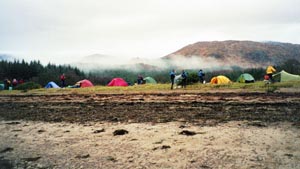2 » Travel and camp on durable surfaces: You'd be surprised how much damage one person can do in what the Americans call "the backcountry". From tramping waterfront plant life, to scattering low-lying scrubs, it's best to stay away from areas that can't handle your presence (cleared areas, existing paths, and rocky clearings are the goal). Keeping to paths and established campsites will help maintain the wilderness areas that you travel through. Stick to established beaches and landing sites.
In Scotland you're unlikely to find too many problems camping wild, especially in the coastal areas. The rest of the UK may be different though. Good manners to ask I guess - and saying thanks afterwards costs nothing. I had an interesting discussion with a lady on the shores of Loch Ffyne who was adamant she owned the foreshore but "as you've asked, of course you can camp". Well, she may not have been strictly correct but hey, being nice got me a cup of tea and some rather splendid cake.
That nice green/yellow/brown stuff on the rock is probably a several hundred year old lichen. Lighting a fire by it isn't going to help it much and neither is scrambling all over it. Camping on the heather is going to flatten it, but it'll recover quickly.
Are those nice yellow flowers some rare species of bog orchid though and is the Pewit merely saying "hi" or trying desperately to get you to shift off it's nest site?
In Scotland, the Land Reform (Scotland) Act 2003 grants some useful Rights & Responsibilities. Please exercise them appropriately and responsibly.

A lovely place to camp, on Loch Etive.
I'd encourage you to think about whether locations of camp sites etc should be included in trip reports or postings on web-forums and the like. Doing so may encourage excessive usage of the same areas and so exposes the land to potential damage. There are usually lots of camping spots and by spreading the load we allow time for nature to recover. On a similar note, people can help by keeping group sizes to a reasonable number, as mentioned earlier.
On the subject of bothies, the MBA maintains a number of these (mainly in Scotland) and asks that locations not be publicised and states that "bothies are not available for groups of 6 or more because of overcrowding and the lack of facilities such as toilets". Bothies aren't "public property", in all cases they belong to the landowners who allow the MBA to maintain them for use by those of us who love to roam, and respect the great outdoors.
Prev |
Next |
| Mike Buckley - September, 2004. | (Page last updated
12-Jun-2006
) |
|